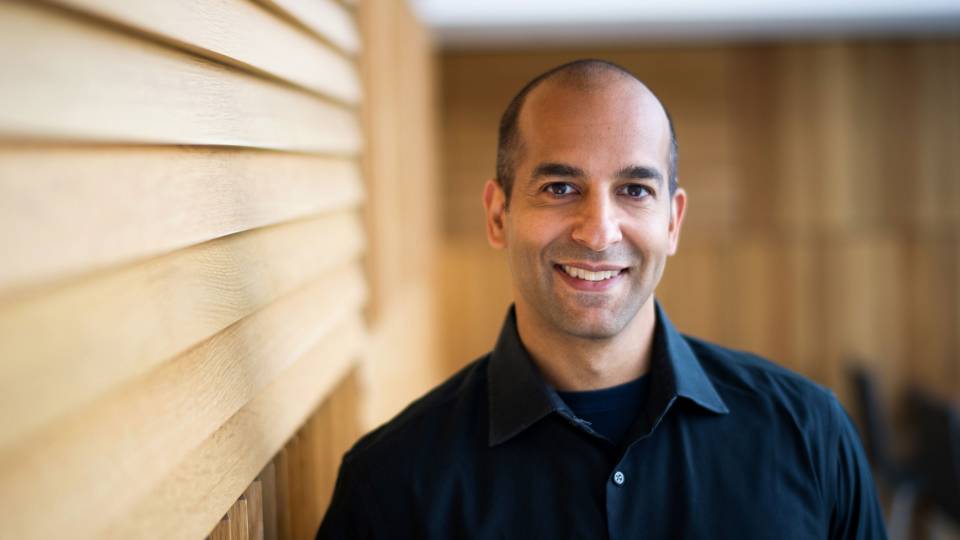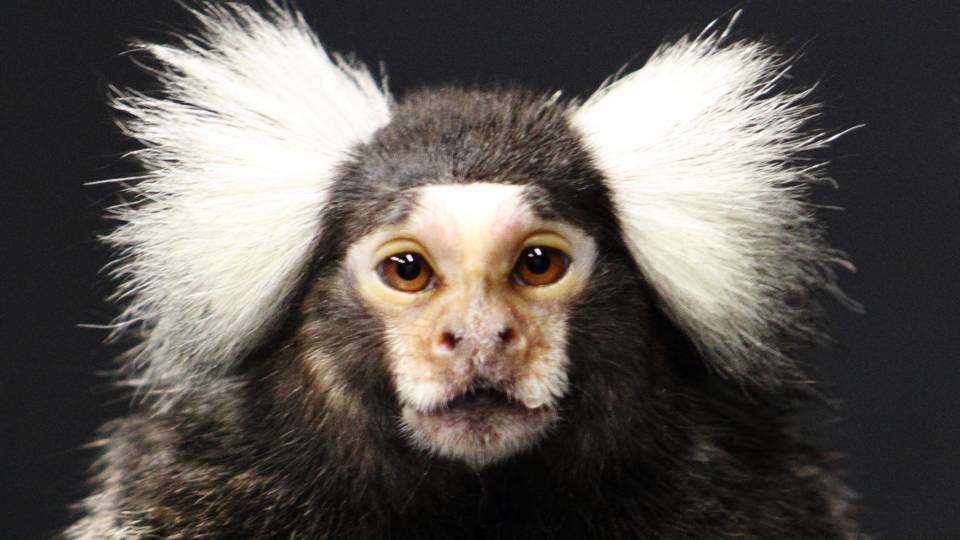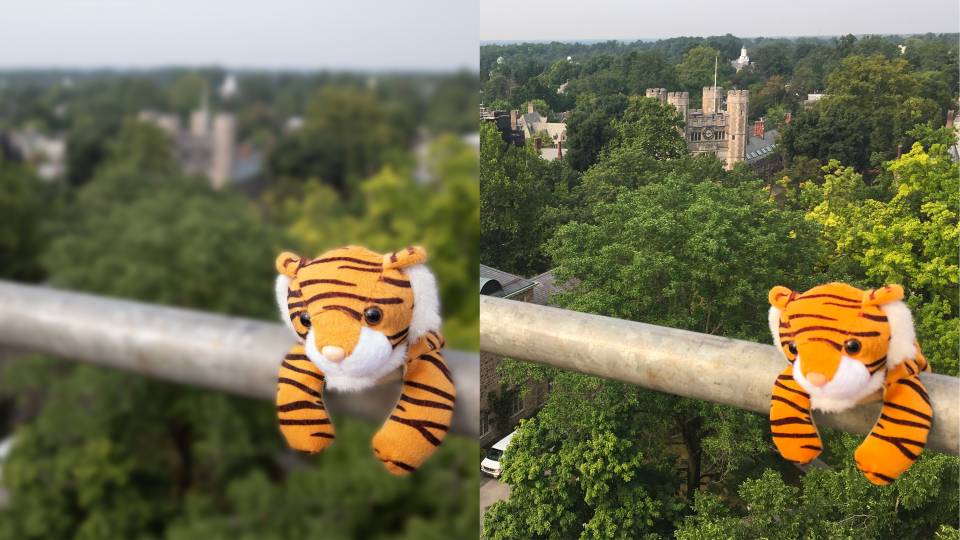Princeton researcher explains link from friendly primate facial gesture to human speech
The throat and facial movements that twist the air pushing through your vocal cords into words could be rooted in the well-meaning expressions primates exchange with each other, according to two recent studies based at Princeton University.
The researchers found that the oral-facial component of human speech mirrors the rhythm, development and internal dynamics of lip smacking, a friendly back-and-forth gesture performed by primates such as chimpanzees, baboons and macaques. The studies also show that the mechanics of primate lip smacking are distinct from those of chewing, similar to the separate mechanics of human speech and chewing.
These parallels suggest that in primates chewing and lip smacking — as with chewing and speech-related facial movement in humans — have separate neural controls, explained Asif Ghazanfar, an associate professor of psychology and the Princeton Neuroscience Institute, and a lead researcher for both studies. With further study, the neural pathway in primates from the brain to facial mechanics could help illuminate the neurological basis of speech disorders in humans, he said.
Ghazanfar and his colleagues first reported in the journal Developmental Science that lip smacking undergoes the same developmental trajectory from infancy to adulthood in rhesus macaques that speech-related mouth movement does in humans. Infant macaques smacked their lips slowly and with an inconsistent rhythm, similar to the documented pace of babbling in human infants. By adulthood, however, lip smacking has a distinct rhythm and a faster pace averaging 5 hertz, or cycles per second — the same as adult humans producing speech. Ghazanfar worked with lead author Ryan Morrill, who received his undergraduate degree from Princeton in 2010; Annika Paukner, a research fellow at the National Institutes of Health; and Pier Ferrari, an assistant professor of biology at the University of Parma in Italy.
In the second paper, published in the journal Current Biology, Ghazanfar and co-author W. Tecumseh Fitch, a professor of cognitive biology at the University of Vienna in Austria, used X-ray movies to film adult rhesus macaques as they smacked their lips or as they chewed food. The researchers observed that during lip smacking, internal structures such as the tongue and hyoid, which houses the larynx, move in pace with the lips with a rhythm of 5 hertz — again, just as in human speech. Also similar to humans, chewing produced a slow, tightly coordinated movement of these components in macaques, while lip smacking resulted in faster, loosely coordinated movement. Ghazanfar, as lead author, wrote the paper with Fitch, Princeton postdoctoral fellow Daniel Takahashi and Neil Mathur, who received his undergraduate degree from Princeton in 2011.
Ghazanfar explains the findings of both papers as follows:
"This research gives us insight into methods of exploring the neural basis of not only facial expression production but also its evolution and relationship to speech. Exploring the neural side of speech production and development can give us a handle on what can go wrong neurophysiologically in human communication disorders. We have few testable ideas about the neural mechanisms that go awry because there is very little work on the production side of communicative expressions.
"In our research, we found that primate lip smacking and the facial component of human speech have the same frequency range, developmental trajectory and involve a similar interplay of the lips, tongue and hyoid. So, if the neural controls for lip smacking are the same as for human speech, then further study of lip smacking in monkeys could reveal more about the brain mechanisms behind human speech.
"Lip smacking is performed by all Old World monkeys and apes, including chimpanzees, and is used in friendly, face-to-face interactions. They often take turns exchanging lip-smacking gestures. Because primate lip smacking has no vocal component, it might seem unrelated to speech, but human speech has two components: the source and the filter. The source component is when the respiratory system pushes air through a person's vocal cords to produce a sound. That sound travels up through the nasal and oral cavities and gets filtered by those cavities. We use our mouths, tongues and lips to actually change the shape of those cavities and, thus, those sounds. That filtering is a separate component with separate neural controls. Our work focuses on this filtering component.
"The connection of speech to lip smacking in primates stems from a theory put forth by [University of Texas-Austin Professor Emeritus of Psychology] Peter MacNeilage in 1998 [in the journal Behavioral and Brain Sciences] that human speech originates from primate facial expressions that were eventually paired with vocal sounds to produce a primitive form of babbling. He proposed that the rhythmicity of those ancestral expressions led to the rhythmicity our faces produce when we speak.
"There are various other theories regarding the evolution of human speech. One theory focuses on the source component and holds that speech evolved from monkey vocalizations, but monkeys don't learn to produce their vocalizations. Pretty much as soon as it is born, a monkey produces the sounds it will produce for the rest of its life; there's not that rich interaction between parent and offspring inherent in human speech. Another theory is that speech evolved when the neural circuits behind the complex manual gestures apes use to communicate shifted over to vocal output.
"We think that MacNeilage offered the only sufficiently clear and testable hypothesis, and we provide the first real empirical support for his theory. Ultimately, our work suggests that the roots of human speech do not lie entirely in primate vocalizations or manual gestures, but are closely related to primate facial expressions.
"We compared lip smacking in rhesus macaques with another oral-facial rhythm, that of chewing. In studies related to speech production and development, it is common to contrast oral-facial movements related to chewing and talking because both actions use the same anatomical structures.
"For the first study, we found in human speech-development literature that when children start to babble, their mouth movements are very slow and variable in rhythmicity. Infants produce these gestures at around 2.5 hertz; in adults, it's around 5 hertz with much less variability. On the other hand, chewing moments are consistently slow and relatively constant from birth to adulthood. That indicates different developmental trajectories, as well as neural controls, for speech and chewing.
"So, if lip smacks have anything to do with the evolution of speech, primates should have a similar developmental trajectory. For our study, we videotaped rhesus macaques of various ages producing lip smacks and used a computer algorithm to measure frame-by-frame the dynamics and rhythmicity of those lip movements. We compared those measurements with chewing movements. Incredibly, the pattern of lip-smack development in the rhesus macaques was identical to the pattern of speech development documented in humans. Moreover, chewing rhythms were basically the same for adult and juvenile primates just as in humans — about 2.5 hertz and without any developmental change. So, lip smacking in Old World monkeys, or at least rhesus macaques, has a similar developmental trajectory as human speech.
"For the second study, we used cineradiography, or X-ray movies, to observe the many internal structures that coordinate with the opening and closing of the mouth to produce speech. We filmed rhesus macaques as they produced lip-smacking expressions and gave them food to elicit chewing movements. When humans chew there's a very predictable relationship between the movements of the jaw, lips, tongue and the hyoid cartilage, which contains the vocal cords. In human speech, the relationship between all these structures is not reliable because of the different sounds involved in speaking. But in chewing the relationship and the ability to predict how the structures will move in relation to one another is very high.
"We saw the same dichotomy in the monkeys: chewing produced a highly stereotyped, functional relationship between the tongue, hyoid and mouth, while during lip smacking the relationship was much looser in those structures. That's another strong piece of evidence that this lip-smack gesture could have easily been co-opted for use in speech. It also suggests that whatever neural controls are involved in chewing don't seem to be equivalently involved in lip smacking and that there's some other type of neural control for lip smacking, which also is suggested when speech and chewing dynamics in humans are compared."
The paper "Monkey Lipsmacking Develops Like the Human Speech Rhythm" was published online April 18 in Developmental Science. The article "Cineradiography of Monkey Lipsmacking Reveals Putative Precursors of Speech Dynamics" was published online May 31 in Current Biology. Both studies were funded in part by the National Institutes of Health and the National Science Foundation.
Information for news media
Ghazanfar is available to discuss his research with interested members of the news media and can be contacted at asifg@princeton.edu, 609-258-9314, or through Princeton University science writer Morgan Kelly at 609-258-5729 or mgnkelly@princeton.edu.



